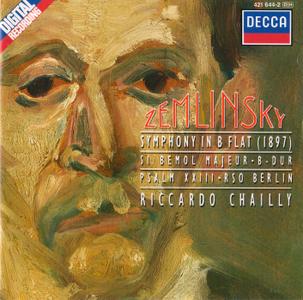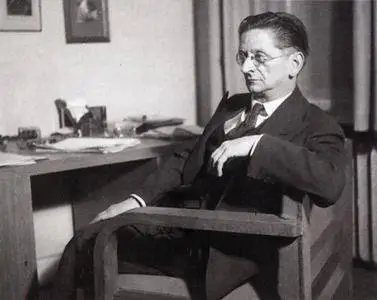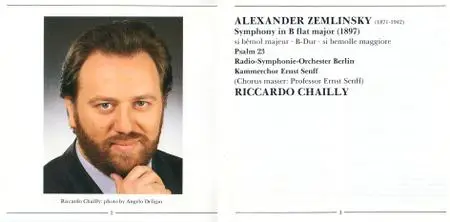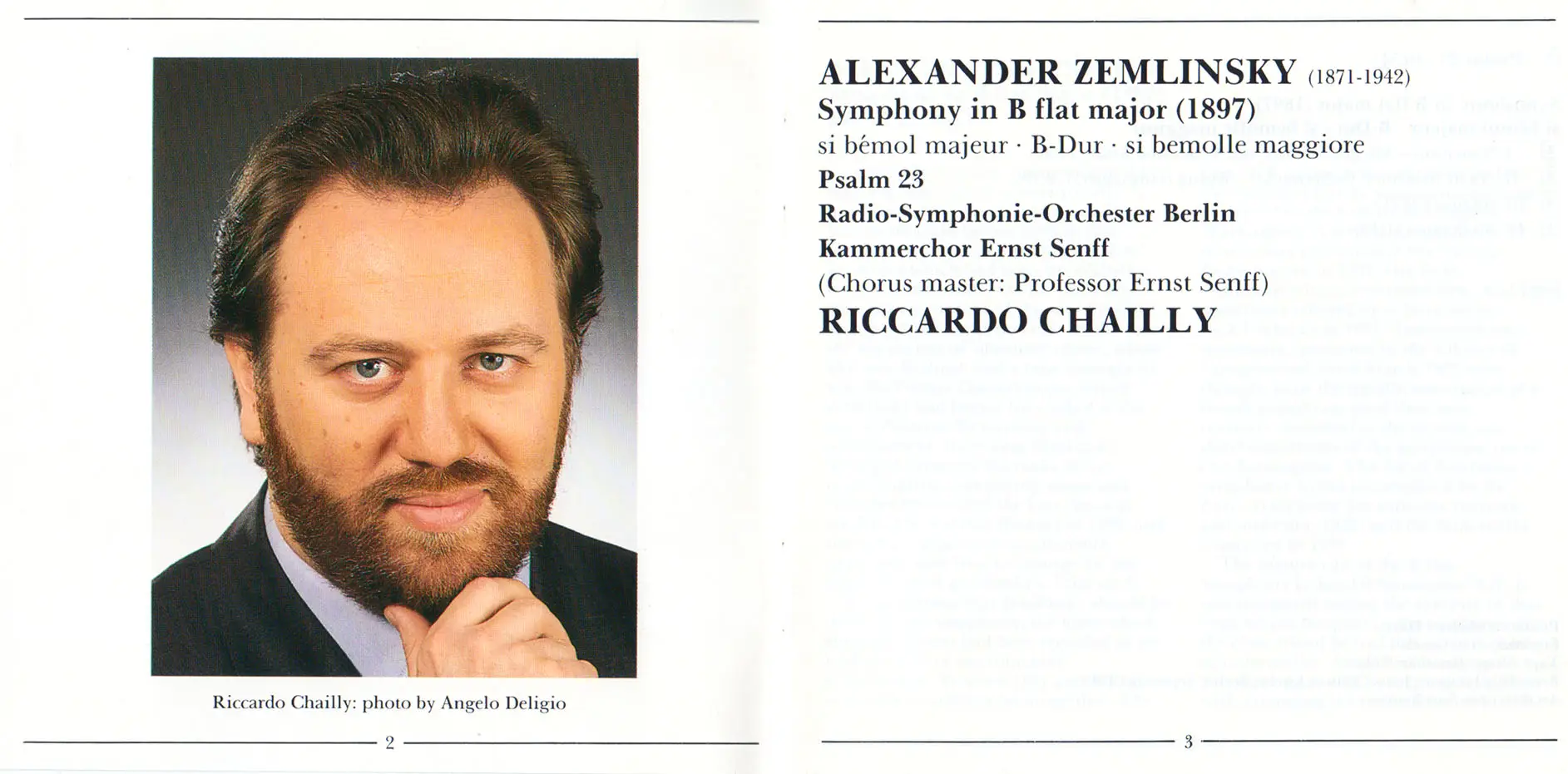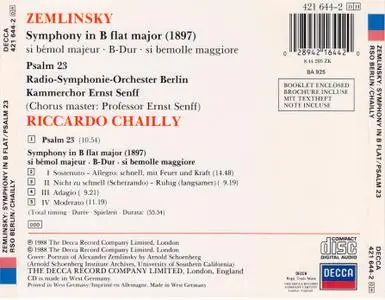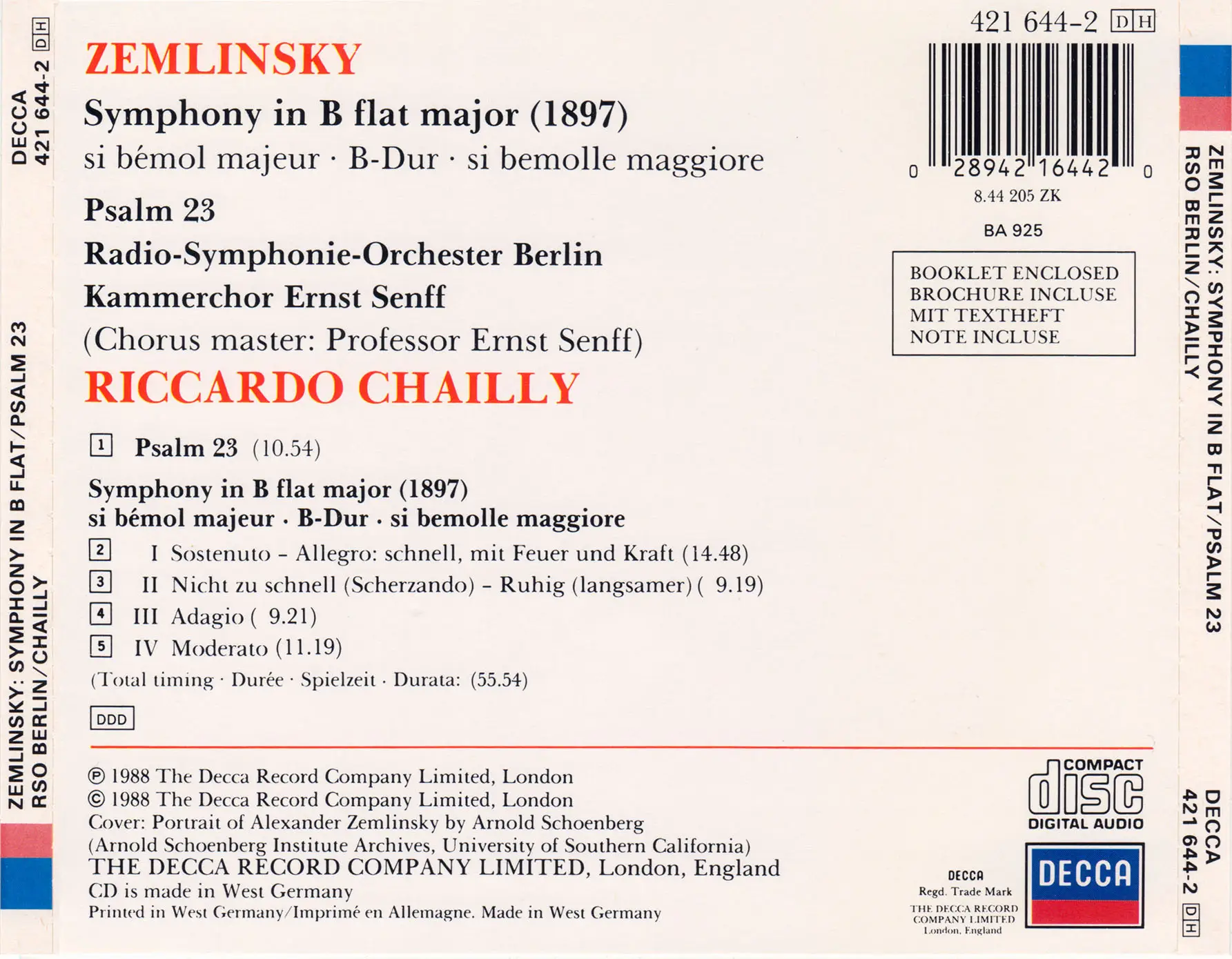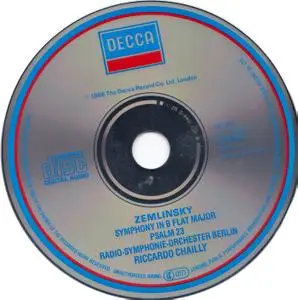Alexander von Zemlinsky: Symphony In B-flat, Psalm 23 (1988)
Radio-Symphonie-Orchester Berlin, Kammerchor Ernst Senff, conducted by Riccardo Chailly
EAC | FLAC | Tracks (Cue&Log) ~ 234 Mb | Mp3 (CBR320) ~ 129 Mb | Scans ~ 45 Mb
Genre: Classical | Label: Decca | # 421 644-2 | Time: 00:55:54
Radio-Symphonie-Orchester Berlin, Kammerchor Ernst Senff, conducted by Riccardo Chailly
EAC | FLAC | Tracks (Cue&Log) ~ 234 Mb | Mp3 (CBR320) ~ 129 Mb | Scans ~ 45 Mb
Genre: Classical | Label: Decca | # 421 644-2 | Time: 00:55:54
During the four years that separated Alexander Zemlinsky's Symphony in D minor and the premiere of the Symphony in B flat major (his first two efforts in the genre, aside from an incomplete work penned during his student years), the young composer had caught the eye and the fancy of the Viennese musical world. "The work's fresh, original ideas and genuinely exalted, youthful fire made a great impression on the audience and unleashed an intense salvo of applause," wrote one critic in response to the 1896 premiere of Zemlinsky's Waldegespräch (for soprano and chamber ensemble). These years also saw Zemlinsky winning two prestigious awards, the Luitpold Prize and the Beethoven Prize. His compositional skills had been refined during the mid 1890s as well. The Suite for Orchestra from 1895, for example, gave Zemlinsky an opportunity to create more adventurous orchestral colors than had been found in the admirable but conservative D minor Symphony. Thus, when one compares the B flat Symphony to his earlier symphonic effort, one notices that, while the same amalgamation of influences and styles is represented, more of the composer's own voice comes through – prompting one observer to suggest two different ways of looking at the work: "either as Zemlinsky's last early work or his first mature one."
Though Zemlinsky had links to the "conservative" faction of the Brahms/Wagner dichotomy (Brahms had even attended an early performance of the D minor Symphony's first movement), he had little interest in the polemics that so sharply divided the two camps. His distance from the volley of words allowed him to freely draw upon both realms of musical innovation, and both of his early symphonies owe moments to Brahms as well as Wagner (and, of course, Wagner's symphonic follower Anton Bruckner). In the B flat Symphony, however, his polystylistic emulation takes on the form of assimilation and innovation. While still utilizing the standard four-movement symphonic form, Zemlinsky ties the movements together in a cyclical fashion through a system of thematic cross-references; a prominent theme in the opening movement, for example, reappears in the subsequent Scherzo and heavily informs the motivic material of the Adagio. The melodies within the work have a lyrical, almost operatic quality, even when those lines are housed within an architectonic musical structure. On the other hand, in the finale, we find a theme and variations form containing a fugato section that seems the direct grandchild of Brahms's classicist pursuits. Many examples of influence are perhaps more difficult to parse, as Zemlinsky's creative orchestration paints familiar gestures in new hues – an example of musical ecumenicism that in turn would be followed by Zemlinsky's pupil, Arnold Schoenberg. "The message [of the B flat major Symphony] is loud and clear," observes Zemlinsky's biographer, Antony Beaumont, "[T]his score marks the end of an apprenticeship. The years of study are over; mastery has been attained."Description by Jeremy Grimshaw, Allmusic.com
The three Psalm settings by Alexander von Zemlinsky are virtually the entirety of his output of sacred music. This one was written during a busy, prosperous phase of his life. He was the First House Conductor at the Vienna Volksoper and in 1907-1908 was on the conducting staff of the Vienna Court Opera, then headed by Gustav Mahler. Zemlinsky's style, like that of his relative by marriage Arnold Schoenberg, took Mahler's style more or less as a point of departure.
The 23rd Psalm is the most famous Psalm (a group of 150 texts in the Judeo-Christian Bible praising God, most traditionally written by King David). It is familiaryly known as the "Shepherd Psalm" and is an extended metaphor of God in the role of a protecting shepherd to each individual of his people. Zemlinsky's setting uses musical color to illustrate the text, such as the flowing oboe solo with its inevitable pastoral associations. He uses an exotic combination (percussion, celesta, glockenspiel, and two harps - King David was a "harp" player) every time an image of nature occurs. The polyphonic style of the choral writing is similar to Brahms' sacred music, although the harmonic language is more chromatic. Some of the melodic material derives from synagogue chants.
This beautiful choral work is about eleven minutes long, and was premiered on December 10, 1910.Description by Joseph Stevenson, Allmusic.com
Alexander Zemlinsky stares mournfully from the Arnold Schönberg portrait that adorns the cover of this Arkiv CD. It is the face of a 39 year old man, unhappily married and busily conducting extra-marital affairs while running the Vienna Volksoper and carving out a career as a composer. In the year this portrait was painted, Zemlinksy wrote the music for the second of his three psalm settings. The first, a setting of Psalm 83, was written a decade earlier. In 1935 he added a setting of Psalm 13.
Zemlinsky’s setting of Psalm 23 is lush and beautiful. There is a the modal flavour to the opening chords and the bucolic cor anglais that almost point to Vaughan Williams. Once the chorus joins, though, the reference points shift to a sound world somewhere between Brahms’ German Requiem and the choral finale to Mahler’s second symphony. This is very much Zemlinsky’s own music, though. Having written two or three operas by the time he penned this piece, his facility in setting text was well established and he captures the mood of the psalm beautifully. Yes, there is reassurance and repose, but there are still shadows in the valley. This contrast gives context to the striving and ecstatic climaxes. The writing for orchestra is just as deft as the writing for chorus, and the Radio-Symphonie-Orchester Berlin revel in its colours, with a rich bloom to the strings especially. Kammerchor Ernst Senff acquit themselves admirably.
The symphony noticeably comes from an earlier time in Zemlinsky’s creative life. It is the work of a 26 year old still trying to assimilate the styles of the composers he revered to forge an idiom of his own. Chailly sounds very much at home here in this late romantic score. He draws out the excitement and the beauty of the music so persuasively that the derivative touches cease to matter in the face of the fresh vitality of the score.
The opening bar of the symphony references the opening of Bruckner’s fourth. Music that could come from Wagner’s Lohengrin follows as the introduction to the first movement builds. Then the introduction is suddenly put down as, with a flourish, the first movement’s exposition gets going with a sunny Dvo?ákian melody that bears more than a passing, if inverted, resemblance to the theme that opens Dvo?ák’s sixth. The ascending violins towards the end of the movement sound like the close of Bruckner’s third, but this idea disappears as soon as it can be identified to make way for the recapitulation, which like the development and the thematic material itself is Dvo?ák through and through.
Dvo?ák is also very present in the second movement, the scherzo. There is some lovely writing for winds here, as Zemlinsky paints expertly with orchestral colours. The adagio that follows has a noble beauty and harks back to Bruckner and Brahms. There is also a touch of Elgar to the flourishes from the violins, though this must be a coincidental anachronism.
The finale opens with a proud, martial statement before pulling back into introspection. There is a foreshadowing of Rachmaninov in the melancholy of this movement, but it tends to meander. The clarinet and horn dialogue, joined by solo violin, is quite lovely though and Zemlinsky manages to pull the threads together for a taut Wagnerian conclusion that, at the death, refers back to the theme of the first movement.
Throughout, the playing of the Radio-Symphonie-Orchester Berlin is superb. There are absolutely no weak spots in ensemble and the commitment of the musicians is total. Chailly made some excellent recordings with this orchestra before moving to the Concertgebouw, including a long-breathed but compelling Bruckner 7 and his classic Mahler 10. This recording belongs in that elite company.
The sound is also excellent. The strings are consistently warm and creamy, and the perspective natural – just listen to the way the tuba sits below the higher voices in the second movement and the finale, retaining its prominence without obscuring other detail. The acoustic of the Jesus Christus Kirche imparts just the right amount of resonance. Hearing this disc makes you wonder why any Berlin orchestra would want to record in the Philharmonie!
Other recordings of the symphony are available, but can be hard to find. James Conlon’s recording, which I have not heard, has recently been given a new lease of life on EMI’s Encore label (EMI Encore 0946 341445 2 0) in harness with the composer’s earlier Symphony in D minor. Naxos offers the same coupling at the same price point. The resurgent Nimbus has a scholarly account on its books.
Chailly’s version, though, does everything Zemlinsky could ever have asked for and comes with a superb coupling from the composer’s maturity. Arkiv has unearthed back catalogue gold in restoring it to circulation.Review by Tim Perry, MusicWeb International (ArkivMusic Reissue)
This is the second recording of Zemlinsky's so-called Second Symphony (in fact his Third, though only two movements of the First survive) and it scores over its predecessor from Edgar Seipenbusch (on Marco Polo/Target) by the greater amplitude of its CD sound and by providing a very interesting fill-up. The fullness of the sound is a slightly mixed blessing, mind you: the charming, Bruckner-off-duty scherzo carries rather too much weight to dance convincingly, and in those few pages where the mature Zemlinsky peers from behind his expertly tailored borrowed garments (as well as Bruckner's baggy suit they include Brahms's tail-coat and Dvorak's rough tweed) his growing mastery of orchestral colour is sometimes obscured by a saturated richness of orchestral timbre. But in all other respects those who don't already have Seipenbusch's smaller-scaled account will find this a no less satisfying exploration of the constituents that were soon to jell into Zemlinsky's mature style.
It is a likeable piece, sometimes because of rather than despite its derivativeness: that scherzo is Brucknerian, but Bruckner could not have written it, just as the passacaglia-finale, an obvious homage to Brahms, is exuberantly prodigal with its ideas in a way that would have set the older master tut-tutting. The first movement, good though its material is, still sounds as though it should have ended two or three minutes before it does, and the turbulent central section of the Adagio still seems more melodramatic than functional, but it was a pleasure to hear the piece again and to see it standing up so well to the opulent treatment that Chailly gives it.
Psalm 23 is much later (it seems to date from around the same time as Zemlinsky's fourth opera, Kleider machen Leute, and the first version of his Maeterlinck songs) and it has much of the colour and the free chromaticism that one would expect. The text and the choral medium, however, have drawn from Zemlinsky a charmingly delicate pastoral lyricism that one does not associate with his name and, in the climaxes, a sonorous diatonicism that evokes an ambience half-way between Hollywood and the Three Choirs Festival. I mean neither comparison dismissively, but the Psalm is in its own way almost as uncharacteristic of Zemlinsky the opera composer and quartet writer as the symphony is. It, too, is very enjoyable, though, and admirably performed; in this work the sumptuousness of the recording is quite appropriate, and obscures nothing.'Review by Michael Oliver, Gramophone
Radio-Symphonie-Orchester Berlin
Ernst Senff Chamber Choir
conducted by Riccardo Chailly
Date of Recording: 09/1987
Venue: Jesus Christus Kirche, Berlin
Tracklist:
Alexander von Zemlinsky (1871-1942)
01. Psalm XXIII: "Der Herr ist mein Hirte" (11:02)
Symphony in B flat (1897):
02. I. Sostenuto - Allegro: schnell, mit Feuer und Kraft (14:51)
03. II. Nicht zu schnell (Scherzando) - Ruhig (langsamer) (9:20)
04. III. Adagio (9:21)
05. IV. Moderato (11:19)
Exact Audio Copy V1.3 from 2. September 2016
EAC extraction logfile from 3. February 2018, 15:47
Zemlinsky, Alexander / Symphony in B flat, Psalm XXIII - RSO Berlin, Riccardo Chailly
Used drive : PLEXTOR CD-R PREMIUM2 Adapter: 5 ID: 1
Read mode : Secure
Utilize accurate stream : Yes
Defeat audio cache : Yes
Make use of C2 pointers : No
Read offset correction : 30
Overread into Lead-In and Lead-Out : Yes
Fill up missing offset samples with silence : Yes
Delete leading and trailing silent blocks : No
Null samples used in CRC calculations : Yes
Used interface : Installed external ASPI interface
Gap handling : Appended to previous track
Used output format : User Defined Encoder
Selected bitrate : 896 kBit/s
Quality : High
Add ID3 tag : No
Command line compressor : C:\Program Files\Exact Audio Copy\Flac\flac.exe
Additional command line options : -6 -V -T "ARTIST=%artist%" -T "TITLE=%title%" -T "ALBUM=%albumtitle%" -T "DATE=%year%" -T "PERFORMER=%albuminterpret%" -T "TRACKNUMBER=%tracknr%" -T "TOTALTRACKS=%numtracks%" -T "GENRE=%genre%" -T "COMPOSER=%composer%" -T "ALBUMARTIST=%albumartist%" -T "ALBUM ARTIST=%albumartist%" -T "COMMENT=EAC V1.3, Secure Mode, Test & Copy, AccurateRip, FLAC 1.3.2 Level 6" %source%
TOC of the extracted CD
Track | Start | Length | Start sector | End sector
––––––––––––––––––––––––––––-
1 | 0:00.33 | 11:02.25 | 33 | 49707
2 | 11:02.58 | 14:51.15 | 49708 | 116547
3 | 25:53.73 | 9:19.60 | 116548 | 158532
4 | 35:13.58 | 9:21.05 | 158533 | 200612
5 | 44:34.63 | 11:19.25 | 200613 | 251562
Track 1
Filename D:\EAC extraction\01 - Psalm XXIII.wav
Pre-gap length 0:00:02.33
Peak level 96.8 %
Extraction speed 1.9 X
Track quality 99.9 %
Test CRC 8399FA4D
Copy CRC 8399FA4D
Accurately ripped (confidence 8) [6B0D0DC1] (AR v2)
Copy OK
Track 2
Filename D:\EAC extraction\02 - Symphony in B flat - I. Sostenuto - Allegro; schnell, mit Feuer und Kraft.wav
Pre-gap length 0:00:08.23
Peak level 96.7 %
Extraction speed 1.9 X
Track quality 100.0 %
Test CRC 6C04A559
Copy CRC 6C04A559
Accurately ripped (confidence 8) [56DE0DEA] (AR v2)
Copy OK
Track 3
Filename D:\EAC extraction\03 - Symphony in B flat - II. Nicht zu schnell (Scherzando) - Ruhig (langsamer).wav
Pre-gap length 0:00:02.70
Peak level 96.8 %
Extraction speed 1.9 X
Track quality 100.0 %
Test CRC 09077795
Copy CRC 09077795
Accurately ripped (confidence 8) [86F45716] (AR v2)
Copy OK
Track 4
Filename D:\EAC extraction\04 - Symphony in B flat - III. Adagio.wav
Pre-gap length 0:00:01.00
Peak level 97.4 %
Extraction speed 1.9 X
Track quality 99.9 %
Test CRC 32920912
Copy CRC 32920912
Accurately ripped (confidence 8) [64B84CCF] (AR v2)
Copy OK
Track 5
Filename D:\EAC extraction\05 - Symphony in B flat - IV. Moderato.wav
Peak level 96.6 %
Extraction speed 1.9 X
Track quality 100.0 %
Test CRC A2A7BB35
Copy CRC A2A7BB35
Accurately ripped (confidence 8) [788493C0] (AR v2)
Copy OK
All tracks accurately ripped
No errors occurred
End of status report
–– CUETools DB Plugin V2.1.6
[CTDB TOCID: PjQKP0ZLk0JDRMDJxmN8KNtSP.0-] found
Submit result: PjQKP0ZLk0JDRMDJxmN8KNtSP.0- has been confirmed
Track | CTDB Status
1 | (13/14) Accurately ripped
2 | (13/14) Accurately ripped
3 | (13/14) Accurately ripped
4 | (13/14) Accurately ripped
5 | (13/14) Accurately ripped
==== Log checksum FC8EF8150F331276D00292E8E485DD5FFC9C5F8E919678DF2559666EC5E72D20 ====
EAC extraction logfile from 3. February 2018, 15:47
Zemlinsky, Alexander / Symphony in B flat, Psalm XXIII - RSO Berlin, Riccardo Chailly
Used drive : PLEXTOR CD-R PREMIUM2 Adapter: 5 ID: 1
Read mode : Secure
Utilize accurate stream : Yes
Defeat audio cache : Yes
Make use of C2 pointers : No
Read offset correction : 30
Overread into Lead-In and Lead-Out : Yes
Fill up missing offset samples with silence : Yes
Delete leading and trailing silent blocks : No
Null samples used in CRC calculations : Yes
Used interface : Installed external ASPI interface
Gap handling : Appended to previous track
Used output format : User Defined Encoder
Selected bitrate : 896 kBit/s
Quality : High
Add ID3 tag : No
Command line compressor : C:\Program Files\Exact Audio Copy\Flac\flac.exe
Additional command line options : -6 -V -T "ARTIST=%artist%" -T "TITLE=%title%" -T "ALBUM=%albumtitle%" -T "DATE=%year%" -T "PERFORMER=%albuminterpret%" -T "TRACKNUMBER=%tracknr%" -T "TOTALTRACKS=%numtracks%" -T "GENRE=%genre%" -T "COMPOSER=%composer%" -T "ALBUMARTIST=%albumartist%" -T "ALBUM ARTIST=%albumartist%" -T "COMMENT=EAC V1.3, Secure Mode, Test & Copy, AccurateRip, FLAC 1.3.2 Level 6" %source%
TOC of the extracted CD
Track | Start | Length | Start sector | End sector
––––––––––––––––––––––––––––-
1 | 0:00.33 | 11:02.25 | 33 | 49707
2 | 11:02.58 | 14:51.15 | 49708 | 116547
3 | 25:53.73 | 9:19.60 | 116548 | 158532
4 | 35:13.58 | 9:21.05 | 158533 | 200612
5 | 44:34.63 | 11:19.25 | 200613 | 251562
Track 1
Filename D:\EAC extraction\01 - Psalm XXIII.wav
Pre-gap length 0:00:02.33
Peak level 96.8 %
Extraction speed 1.9 X
Track quality 99.9 %
Test CRC 8399FA4D
Copy CRC 8399FA4D
Accurately ripped (confidence 8) [6B0D0DC1] (AR v2)
Copy OK
Track 2
Filename D:\EAC extraction\02 - Symphony in B flat - I. Sostenuto - Allegro; schnell, mit Feuer und Kraft.wav
Pre-gap length 0:00:08.23
Peak level 96.7 %
Extraction speed 1.9 X
Track quality 100.0 %
Test CRC 6C04A559
Copy CRC 6C04A559
Accurately ripped (confidence 8) [56DE0DEA] (AR v2)
Copy OK
Track 3
Filename D:\EAC extraction\03 - Symphony in B flat - II. Nicht zu schnell (Scherzando) - Ruhig (langsamer).wav
Pre-gap length 0:00:02.70
Peak level 96.8 %
Extraction speed 1.9 X
Track quality 100.0 %
Test CRC 09077795
Copy CRC 09077795
Accurately ripped (confidence 8) [86F45716] (AR v2)
Copy OK
Track 4
Filename D:\EAC extraction\04 - Symphony in B flat - III. Adagio.wav
Pre-gap length 0:00:01.00
Peak level 97.4 %
Extraction speed 1.9 X
Track quality 99.9 %
Test CRC 32920912
Copy CRC 32920912
Accurately ripped (confidence 8) [64B84CCF] (AR v2)
Copy OK
Track 5
Filename D:\EAC extraction\05 - Symphony in B flat - IV. Moderato.wav
Peak level 96.6 %
Extraction speed 1.9 X
Track quality 100.0 %
Test CRC A2A7BB35
Copy CRC A2A7BB35
Accurately ripped (confidence 8) [788493C0] (AR v2)
Copy OK
All tracks accurately ripped
No errors occurred
End of status report
–– CUETools DB Plugin V2.1.6
[CTDB TOCID: PjQKP0ZLk0JDRMDJxmN8KNtSP.0-] found
Submit result: PjQKP0ZLk0JDRMDJxmN8KNtSP.0- has been confirmed
Track | CTDB Status
1 | (13/14) Accurately ripped
2 | (13/14) Accurately ripped
3 | (13/14) Accurately ripped
4 | (13/14) Accurately ripped
5 | (13/14) Accurately ripped
==== Log checksum FC8EF8150F331276D00292E8E485DD5FFC9C5F8E919678DF2559666EC5E72D20 ====
[CUETools log; Date: 28.10.2019 22:23:41; Version: 2.1.4]
Pregap length 00:00:33.
[CTDB TOCID: PjQKP0ZLk0JDRMDJxmN8KNtSP.0-] found.
Track | CTDB Status
1 | (20/21) Accurately ripped
2 | (20/21) Accurately ripped
3 | (20/21) Accurately ripped
4 | (20/21) Accurately ripped
5 | (20/21) Accurately ripped
[AccurateRip ID: 000bdb26-0036dd94-400d1a05] found.
Track [ CRC | V2 ] Status
01 [225d13ef|6b0d0dc1] (05+09/19) Accurately ripped
02 [f335a57f|56de0dea] (05+09/19) Accurately ripped
03 [29e01a0f|86f45716] (05+09/19) Accurately ripped
04 [34f146b8|64b84ccf] (05+09/19) Accurately ripped
05 [86d5c6d5|788493c0] (05+08/18) Accurately ripped
Offsetted by -627:
01 [c9d0c7f6] (00/19) No match (V2 was not tested)
02 [7d6ec0b0] (00/19) No match (V2 was not tested)
03 [b3a48696] (00/19) No match (V2 was not tested)
04 [f3fcad7c] (00/19) No match (V2 was not tested)
05 [ab484245] (00/18) No match (V2 was not tested)
Track Peak [ CRC32 ] [W/O NULL] [ LOG ]
– 97,4 [3298B2F3] [BFD2C56A]
01 96,8 [8399FA4D] [BF273D2E] CRC32
02 96,7 [6C04A559] [33E8020D] CRC32
03 96,8 [09077795] [3A2C1DB5] CRC32
04 97,4 [32920912] [720CFC7F] CRC32
05 96,6 [A2A7BB35] [CA0B6A89] CRC32
Pregap length 00:00:33.
[CTDB TOCID: PjQKP0ZLk0JDRMDJxmN8KNtSP.0-] found.
Track | CTDB Status
1 | (20/21) Accurately ripped
2 | (20/21) Accurately ripped
3 | (20/21) Accurately ripped
4 | (20/21) Accurately ripped
5 | (20/21) Accurately ripped
[AccurateRip ID: 000bdb26-0036dd94-400d1a05] found.
Track [ CRC | V2 ] Status
01 [225d13ef|6b0d0dc1] (05+09/19) Accurately ripped
02 [f335a57f|56de0dea] (05+09/19) Accurately ripped
03 [29e01a0f|86f45716] (05+09/19) Accurately ripped
04 [34f146b8|64b84ccf] (05+09/19) Accurately ripped
05 [86d5c6d5|788493c0] (05+08/18) Accurately ripped
Offsetted by -627:
01 [c9d0c7f6] (00/19) No match (V2 was not tested)
02 [7d6ec0b0] (00/19) No match (V2 was not tested)
03 [b3a48696] (00/19) No match (V2 was not tested)
04 [f3fcad7c] (00/19) No match (V2 was not tested)
05 [ab484245] (00/18) No match (V2 was not tested)
Track Peak [ CRC32 ] [W/O NULL] [ LOG ]
– 97,4 [3298B2F3] [BFD2C56A]
01 96,8 [8399FA4D] [BF273D2E] CRC32
02 96,7 [6C04A559] [33E8020D] CRC32
03 96,8 [09077795] [3A2C1DB5] CRC32
04 97,4 [32920912] [720CFC7F] CRC32
05 96,6 [A2A7BB35] [CA0B6A89] CRC32
foobar2000 1.2 / Dynamic Range Meter 1.1.1
log date: 2019-10-28 22:25:43
––––––––––––––––––––––––––––––––––––––––
Analyzed: Zemlinsky, Alexander / Symphony in B flat • Psalm XXIII / Radio-Symphonie-Orchester Berlin, Riccardo Chailly
––––––––––––––––––––––––––––––––––––––––
DR Peak RMS Duration Track
––––––––––––––––––––––––––––––––––––––––
DR14 -0.28 dB -20.11 dB 11:02 01-Psalm XXIII: "Der Herr ist mein Hirte"
DR14 -0.29 dB -19.21 dB 14:51 02-Symphony in B flat (1897): I. Sostenuto - Allegro: schnell, mit Feuer und Kraft
DR14 -0.28 dB -18.89 dB 9:20 03-Symphony in B flat (1897): II. Nicht zu schnell (Scherzando) - Ruhig (langsamer)
DR15 -0.22 dB -22.55 dB 9:21 04-Symphony in B flat (1897): III. Adagio
DR14 -0.30 dB -20.14 dB 11:19 05-Symphony in B flat (1897): IV. Moderato
––––––––––––––––––––––––––––––––––––––––
Number of tracks: 5
Official DR value: DR14
Samplerate: 44100 Hz
Channels: 2
Bits per sample: 16
Bitrate: 556 kbps
Codec: FLAC
================================================================================
log date: 2019-10-28 22:25:43
––––––––––––––––––––––––––––––––––––––––
Analyzed: Zemlinsky, Alexander / Symphony in B flat • Psalm XXIII / Radio-Symphonie-Orchester Berlin, Riccardo Chailly
––––––––––––––––––––––––––––––––––––––––
DR Peak RMS Duration Track
––––––––––––––––––––––––––––––––––––––––
DR14 -0.28 dB -20.11 dB 11:02 01-Psalm XXIII: "Der Herr ist mein Hirte"
DR14 -0.29 dB -19.21 dB 14:51 02-Symphony in B flat (1897): I. Sostenuto - Allegro: schnell, mit Feuer und Kraft
DR14 -0.28 dB -18.89 dB 9:20 03-Symphony in B flat (1897): II. Nicht zu schnell (Scherzando) - Ruhig (langsamer)
DR15 -0.22 dB -22.55 dB 9:21 04-Symphony in B flat (1897): III. Adagio
DR14 -0.30 dB -20.14 dB 11:19 05-Symphony in B flat (1897): IV. Moderato
––––––––––––––––––––––––––––––––––––––––
Number of tracks: 5
Official DR value: DR14
Samplerate: 44100 Hz
Channels: 2
Bits per sample: 16
Bitrate: 556 kbps
Codec: FLAC
================================================================================


